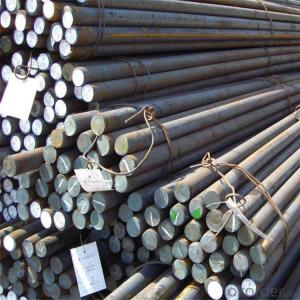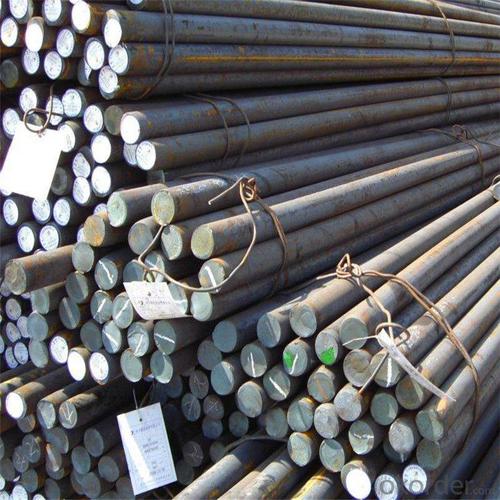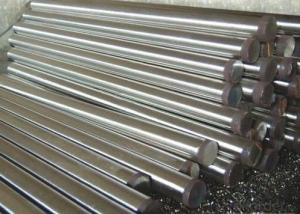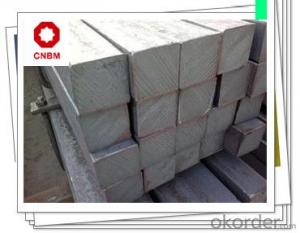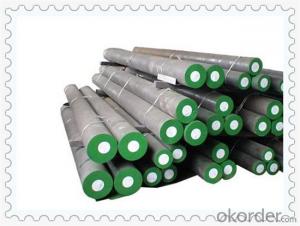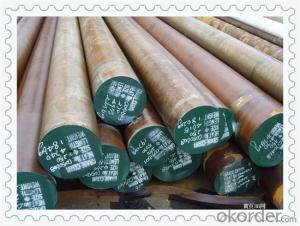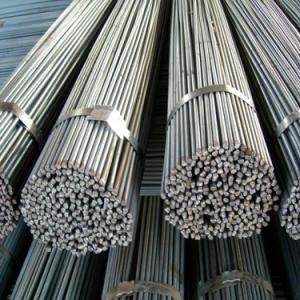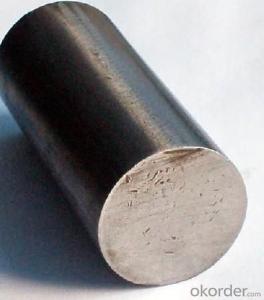Annealing Peeling Bearing Steel SUJ2 Bars
- Loading Port:
- Shanghai
- Payment Terms:
- TT OR LC
- Min Order Qty:
- 100 m.t.
- Supply Capability:
- 50000 m.t./month
OKorder Service Pledge
OKorder Financial Service
You Might Also Like
Specification
Annealing Peeling Bearing Steel SUJ2 Bars
Product Description of Annealing Peeling Bearing Steel SUJ2 Bars
1. Steel grade: ASTM52100, SUJ2, 100Gr6,GCr15
2. Length: 6M-12M
3. Diameter: 16mm-300mm
4. Product range: round bar, flat bar, square bar,wire rod, sheet
5. Technique: Hot rolled, forged, cold drawn
Specification of Annealing Peeling Bearing Steel SUJ2 Bars
Material | SUJ2 | Round bar | Dia(mm) | 10-300mm |
Process | EAF + LF + VD + Forged + Heat Treatment (optional) | Length (mm) | Max 12m | |
Heat treatment | Normalized / Annealed / Quenched / tempered | Flat bar | Thickness(mm) | 8-500mm |
Delivery condition | Hot forged +Rough machined (black surface after Q/T)+ Turned (optional) | Width(mm) | 70-200mm | |
Test | Ultrasonic test according to SEP 1921-84 D/d | Length (mm) | Max 12m |
Chemical Composition of Annealing Peeling Bearing Steel SUJ2 Bars
C | Si | Mn | Cr | Ni | Mo | P | S |
0.95~1.05 | 0.15~0.35 | 0.25~0.45 | 1.40~1.65 | ≤0.30 | ≤0.10 | ≤0.025 | ≤0.025 |
Photo Show of Annealing Peeling Bearing Steel SUJ2 Bars
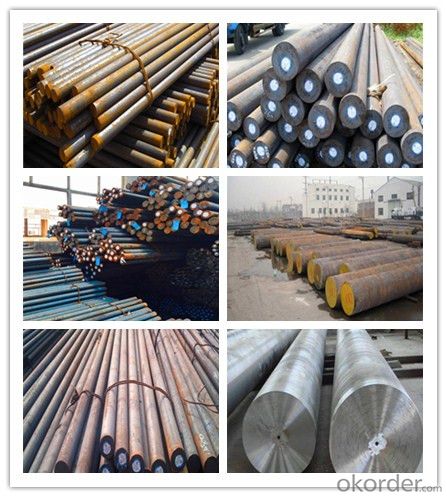
Packing and Delivery:
Packing in bundle package, or as customer's requirements.
Delivery Detail: 45 days after receiving the deposit.
Usage and Applications of Annealing Peeling Bearing Steel SUJ2 Bars
1. Steel round bar is used in a large number of architectural and engineering structures. Or it can be used in construction of plants for the production of steel house frames, high-voltage transmission towers, bridges, vehicles, boilers, containers, ships, etc.
2. And we can use this kind of product on the performance of the mechanical parts if the demand is not very high.
3. Some special material steel round bar can be used for main shaft of steamer, hummer shank, with big section and supper force.
Company Information
CNBM International Corporation is the most important trading platform of CNBM group.
Whith its advantages, CNBM International are mainly concentrate on Cement, Glass, Iron and Steel, Ceramics industries and devotes herself for supplying high qulity series of refractories as well as technical consultancies and logistics solutions.


F A Q
1, Your advantages?
professional products inquiry, products knowledge train (for agents), smooth goods delivery, excellent customer solution proposale
2, Test & Certificate?
SGS test is available, customer inspection before shipping is welcome, third party inspection is no problem
3, Factory or Trading Company?
CNBM is a trading company but we have so many protocol factories and CNBM works as a trading department of these factories. Also CNBM is the holding company of many factories.
4, Payment Terms?
30% TT as deposit and 70% before delivery.
Irrevocable L/C at sight.
5, Trading Terms?
EXW, FOB, CIF, FFR, CNF
6, After-sale Service?
CNBM provides the services and support you need for every step of our cooperation. We're the business partner you can trust.
For any problem, please kindly contact us at any your convenient time.
We'll reply you in our first priority within 24 hours.
- Q: What are the advantages of using tungsten-alloy steel round bars?
- Tungsten-alloy steel round bars have become a popular choice in various industries due to their numerous advantages over other materials. Firstly, their exceptional strength and durability make them highly resistant to wear, deformation, and fatigue. By adding tungsten to the steel composition, the bars become significantly harder and tougher, enabling them to withstand heavy loads and high-pressure applications. This makes them ideal for industries such as aerospace, automotive, and construction. Another advantage of these round bars is their excellent heat resistance. Tungsten has one of the highest melting points among all elements, making it perfect for applications involving extreme temperatures. Whether it's furnace parts, cutting tools, or high-speed machinery, the heat resistance of tungsten-alloy steel round bars ensures that they maintain their structural integrity and performance in demanding environments. This reduces the risk of deformation or failure. Furthermore, these round bars possess superior corrosion resistance. The inclusion of tungsten in the steel alloy creates a protective oxide layer on the surface, acting as a barrier against corrosive elements, moisture, and chemicals. This corrosion resistance makes tungsten-alloy steel round bars highly suitable for applications in marine environments, chemical processing plants, and the oil and gas industry, where exposure to corrosive substances is common. Additionally, these round bars offer excellent machinability. Their hardness and toughness make them easy to shape, cut, and drill, allowing for precise machining and tight tolerances. This makes tungsten-alloy steel round bars suitable for manufacturing intricate components and parts that require high precision and accuracy. Lastly, the high density of tungsten-alloy steel round bars gives them unique properties, such as improved radiation shielding capabilities. This makes them invaluable in industries where radiation protection is crucial, such as nuclear power plants, medical equipment, and aerospace applications. In conclusion, the advantages of using tungsten-alloy steel round bars include exceptional strength and durability, excellent heat resistance, superior corrosion resistance, excellent machinability, and high density for radiation shielding. These advantages make tungsten-alloy steel round bars a reliable and versatile choice for various industries, ensuring optimal performance and longevity in challenging environments.
- Q: What are the advantages of using silicon-alloy steel round bars?
- Silicon-alloy steel round bars offer several benefits that make them a favorable choice. Firstly, their strength and durability are exceptional, making them suitable for heavy-duty applications. Their high tensile strength allows them to withstand heavy loads and resist deformation, ensuring reliability for mechanical and structural purposes. Secondly, these round bars exhibit excellent heat resistance. The presence of silicon in the alloy enhances their ability to handle high temperatures without compromising their structural integrity. This makes them ideal for applications that involve exposure to extreme heat, such as furnace components, exhaust systems, or high-temperature equipment. Furthermore, silicon-alloy steel round bars provide remarkable corrosion resistance. The inclusion of alloying elements like chromium and nickel creates a protective oxide layer on the surface, preventing corrosion and extending their lifespan. This makes them suitable for use in corrosive atmospheres and marine environments. Additionally, these round bars offer good machinability and weldability. Their ease of forming into various shapes and sizes makes them versatile for different manufacturing processes. Moreover, their weldability allows for easy fabrication and customization, making them convenient for numerous industries. Lastly, silicon-alloy steel round bars are cost-effective. In comparison to other high-performance alloys, they are relatively more affordable, making them a cost-effective option for applications that require strength, durability, heat resistance, and corrosion resistance. In conclusion, the advantages of silicon-alloy steel round bars encompass their excellent strength and durability, good heat resistance, corrosion resistance, machinability, weldability, and cost-effectiveness. These attributes establish silicon-alloy steel as a versatile and reliable material for various industrial applications.
- Q: What are the properties of steel round bars?
- Steel round bars have several properties that make them highly desirable for a wide range of applications. Firstly, they possess exceptional strength and durability, making them suitable for load-bearing structures and heavy-duty machinery. Additionally, steel round bars exhibit excellent corrosion resistance, allowing them to withstand harsh environmental conditions without compromising their integrity. They also have a high melting point and can withstand extreme temperatures, making them ideal for applications that involve heat or fire. Furthermore, steel round bars can be easily machined, welded, and fabricated, providing flexibility in design and construction processes. Lastly, they offer good dimensional stability and precise tolerances, ensuring consistent performance and reliability in various industrial and construction settings.
- Q: What are the different surface coatings available for steel round bars?
- There are several different surface coatings available for steel round bars, each with their own unique benefits and applications. Some of the most common surface coatings include: 1. Galvanized Coating: This involves applying a layer of zinc to the surface of the steel round bar through a process called hot-dip galvanizing. The zinc coating provides excellent corrosion resistance, protecting the steel from rust and other forms of degradation. Galvanized coatings are commonly used in outdoor and high-humidity environments. 2. Epoxy Coating: Epoxy coatings are applied as a powder or liquid and then cured through a chemical reaction. They offer excellent chemical resistance, durability, and protection against corrosion. Epoxy coatings are often used in industrial and marine applications where harsh chemicals or saltwater exposure are a concern. 3. Chrome Plating: This involves electroplating a layer of chromium onto the surface of the steel round bar. Chrome plating offers high corrosion resistance, as well as excellent hardness and wear resistance. It is commonly used in applications where aesthetic appeal and enhanced durability are desired, such as automotive parts and decorative fixtures. 4. Powder Coating: Powder coating is a dry finishing process that involves applying a powdered polymer to the surface of the steel round bar and then heat-curing it. This creates a durable and decorative finish that is resistant to chipping, scratching, and fading. Powder coatings are available in a wide range of colors and textures, making them popular for architectural and decorative purposes. 5. Black Oxide Coating: Black oxide is a conversion coating that is created by a chemical reaction with the steel surface. It provides a black, decorative finish while also offering mild corrosion resistance. Black oxide coatings are commonly used in applications where an aesthetic appearance is desired, such as firearms and hardware. These are just a few examples of the different surface coatings available for steel round bars. The choice of coating will depend on the specific requirements of the application, including the desired level of corrosion resistance, durability, and aesthetic appeal.
- Q: Can steel round bars be welded?
- Steel round bars can indeed be welded, as welding is a widely employed technique for connecting them. This involves heating the bars to a considerable temperature and subsequently applying pressure to fuse them, resulting in robust and long-lasting connections. Nonetheless, it is crucial to utilize suitable welding techniques and equipment in order to attain a weld of superior quality.
- Q: Can steel round bars be welded to other materials?
- Other materials can indeed be joined with steel round bars through welding. Welding is a widely used technique for merging various materials, including steel round bars, aluminum, stainless steel, and even non-metallic substances like plastics. However, it is vital to emphasize that successful welding depends on the compatibility of the materials being joined. To ensure a robust and long-lasting bond between the steel round bar and the other material, the welding process necessitates the use of appropriate techniques, filler metals, and sometimes pre-heating or post-weld heat treatment. Moreover, it is important to consider the specific application and the desired properties of the joint in order to determine the most suitable welding method and materials.
- Q: What are the different types of steel round bars used in the automotive exhaust systems?
- There are several different types of steel round bars used in automotive exhaust systems, each with its own unique properties and applications. Here are some of the most common types: 1. Stainless Steel Round Bars: Stainless steel is a popular choice for exhaust systems due to its excellent corrosion resistance and high temperature resistance. It is commonly used in both the primary and secondary components of the exhaust system, such as headers, catalytic converters, and mufflers. 2. Carbon Steel Round Bars: Carbon steel is another commonly used material in exhaust systems. It provides good strength and durability, making it suitable for various components like exhaust pipes and hangers. However, carbon steel is more prone to corrosion compared to stainless steel, so proper coating or treatment is necessary to prevent rusting. 3. Aluminized Steel Round Bars: Aluminized steel is carbon steel that has been coated with an aluminum-silicon alloy. This coating provides excellent corrosion resistance and heat reflectivity, making it an ideal choice for exhaust systems. Aluminized steel is often used in exhaust pipes and mufflers, as it helps to reduce heat buildup and improve overall durability. 4. Titanium Round Bars: Although less commonly used due to its high cost, titanium is an extremely lightweight and durable material that offers exceptional corrosion resistance. In high-performance or specialty exhaust systems, titanium round bars may be used to reduce weight and enhance overall performance. It is often found in exhaust tips and high-end aftermarket exhaust systems. Overall, the choice of steel round bars for automotive exhaust systems depends on factors such as cost, performance requirements, and specific application needs. Manufacturers carefully select the appropriate type of steel to ensure longevity, efficiency, and compliance with emissions regulations.
- Q: What is the difference between a smooth and a precision ground steel round bar?
- A smooth steel round bar is a steel rod with a plain surface and no specific surface treatment or finishing process. It is typically made through hot rolling or cold drawing, resulting in a basic cylindrical shape with a relatively rough surface texture. Smooth steel round bars are commonly used in various applications where a smooth exterior finish is not crucial. On the other hand, a precision ground steel round bar goes through an extra manufacturing process to achieve a more precise and refined surface finish. The process involves removing any imperfections or irregularities from the steel rod's surface, resulting in a highly smooth and polished finish. This ensures that the round bar maintains a consistent diameter along its length and has a superior level of finish and accuracy. Precision ground steel round bars are widely used in applications that require tight tolerances, precision machining, or a smooth and polished surface. Industries such as aerospace, automotive, tooling, and manufacturing often rely on precision ground steel round bars for their high-quality surface finish, dimensional accuracy, and reliable performance. In conclusion, the main distinction between a smooth and a precision ground steel round bar lies in the surface finish and level of precision achieved. While a smooth steel round bar has a basic, rough surface texture and is suitable for general applications, a precision ground steel round bar undergoes additional grinding processes to achieve a highly smooth, polished, and accurate surface finish. This makes it ideal for applications requiring tight tolerances and precision machining.
- Q: How do I calculate the length of a steel round bar based on weight?
- In order to determine the length of a steel round bar based on its weight, there are a few factors to consider. Firstly, you must be aware of the density of steel, which typically ranges around 7850 kilograms per cubic meter. However, it's worth noting that this value can vary depending on the specific type and grade of steel being utilized. After obtaining the density value, the next step involves converting the weight of the steel round bar into kilograms if it is initially given in a different unit. For instance, if the weight is provided in pounds, you can multiply it by 0.4536 to convert it into kilograms. Once you have successfully converted the weight into kilograms, you can proceed with using the following formula to calculate the length: Length = Weight / (Density * π * (Diameter/2)^2) It's important to ensure that the diameter is measured in meters. If the diameter is given in a different unit, it must be converted accordingly. Additionally, the symbol "π" represents the mathematical constant pi, which is approximately equal to 3.14159. By substituting the appropriate values into the formula, you will be able to accurately determine the length of the steel round bar. Remember to maintain consistent units throughout the calculation to yield precise results. Please bear in mind that this calculation assumes the round bar possesses a consistent diameter along its entire length. If the bar exhibits varying diameters or irregularities, the resulting length may be an approximation rather than an exact measurement.
- Q: How do steel round bars compare to wood round bars?
- Steel round bars and wood round bars have several distinct differences that set them apart. Firstly, steel round bars are significantly stronger and more durable than their wooden counterparts. Steel has a much higher tensile strength, making it capable of withstanding heavy loads and resisting bending or breaking. This makes steel round bars ideal for applications where strength and durability are paramount, such as in construction, engineering, or manufacturing. On the other hand, wood round bars have their own advantages. Wood is a natural material that is lightweight and easy to work with. It can be easily cut, shaped, and crafted to fit specific requirements. Additionally, wood has a warm and aesthetic appeal that steel lacks, making it a popular choice in furniture, interior design, and other decorative applications. Another significant difference lies in their resistance to environmental factors. Steel is highly resistant to moisture, pests, and rot, making it suitable for outdoor or high-moisture environments. Wood, however, is susceptible to these elements and requires regular treatment and maintenance to prevent damage. Cost is another factor to consider. Steel round bars are generally more expensive than wood round bars due to the higher cost of materials and production processes involved. Wood, being a natural resource, is often more cost-effective. Ultimately, the choice between steel and wood round bars depends on the specific requirements of the project. If strength, durability, and resistance to environmental factors are crucial, steel round bars are the preferable choice. However, if a lightweight, aesthetic, and cost-effective option is required, wood round bars may be more suitable.
Send your message to us
Annealing Peeling Bearing Steel SUJ2 Bars
- Loading Port:
- Shanghai
- Payment Terms:
- TT OR LC
- Min Order Qty:
- 100 m.t.
- Supply Capability:
- 50000 m.t./month
OKorder Service Pledge
OKorder Financial Service
Similar products
Hot products
Hot Searches
Related keywords
